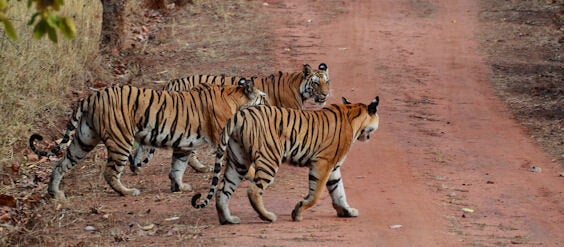There are only around 3000 tigers left in the wild worldwide. To put this into context that's less than the number of tigers in captivity in the US - a figure and comparison that I find shocking.

Tigers in Bandhavgarh National Park, India. Credit: Brian Gratwicke
It also explains why seeing a wild tiger on safari has been described as such a touching experience; for some the opportunity to come face to face with these majestic creatures in their natural habitat, a sight so privileged and rare, elicits a deep emotional and spiritual response. And it may just be the force of this emotion in the hearts of travellers which could bolster the tiger's battle against habitat loss, poaching and the thriving trade in Traditional Chinese Medicine.
Paul Goldstein, tiger safari guide and expert at responsibletravel.com member Exodus sums up the wild tiger's situation succinctly, "this is an animal we are likely to lose in our lifetime and the blame has a face, and that face is China". Rooted in customs and beliefs going back centuries, Traditional Chinese Medicine to this day drives trade in a number of endangered species. Rather than its magnificence in the wild, it is instead the sum of the tiger's body parts which is prized most highly, with its eyes used to treat epilepsy, its bones to treat rheumatism, its brain to treat acne and, most famously, its penis for use as an aphrodisiac.
Encouragingly the World Federation of Chinese Medicine Societies did ask its members to stop using tiger parts, and parts from any endangered wildlife back in 2010, but demand nonetheless remains high. Rarity has given tiger-based remedies a hefty price-tag, seen as prestigious resources for the wealthy and privileged and worryingly it seems this status is behind the demand. And as the Chinese economy booms it sounds the death knell for tigers worldwide.
We can't lay the blame entirely at China's feet however. Initially it was royalty, be it Mughals, Maharajas or British which decimated tiger populations with trophy hunting, and even today, although driven by the Chinese medicine trade, poachers on the ground are not being tackled efficiently. It may seem a hopeless cause, and yes some people may say that it is one that the conservationists won't win, but tigers do have something else fighting their corner. Tourism. And although the might of Chinese tradition will be very difficult to change; what tourism can do is help bring an end to tiger poaching, playing a vital role in stopping the supply of tiger parts and bolstering the fight of those conserving and protecting these beautiful animals.
It is therefore up to us, as tourists, to support and encourage responsible tourism in tiger wilderness areas, as well as supporting the NGOs and organisations running conservation and education programmes. The responsible tiger safari industry in places such as India and Nepal offers local people a key way to make a sustainable living without the need for poaching. It is an industry which places value on the protection and preservation of tigers in the wild and one which can translate this value into income for local communities. If tour operators and conservationists can work in conjunction with local people, can ensure that tourism to wild tiger areas truly supports these communities then the tiger stands a chance at survival. Whether selling traditional crafts, setting up local restaurants, training as park guides, drivers or running local guesthouses - tour operators need to ensure that local people are involved in every aspect of a client's safari experience to make this work.
Tourism could also help tackle the problem from the other side. Yes a booming Chinese economy may be driving demand for expensive tiger products, but it is also allowing Chinese tourists to become much more widely travelled. The opportunity to see tigers in the wild, to experience the emotion of seeing such an iconic and rare creature in its natural environment is perhaps one of the best ways to educate about the need to stop a trade which is threatening its very existence. The controversy surrounding tigers and traditional medicine is well-known in China, and it is hard to imagine that any Chinese tourists on a tiger safari would then want to see them cut up for their parts. And through engagement and debate, we can encourage them to raise awareness on their return home.
So is responsible tourism strong enough to take on this challenge? While it may not be able to alter Chinese tradition it certainly offers an opportunity to permanently reduce poaching, a ray of hope for the survival of a truly awe-inspiring creature. However in order for this to work it comes down to each of us as individual tourists to make the right decisions with our holidays, to choose the tour operator which is working to provide livelihoods within the tourism industry for local people and one which is actively supporting conservation initiatives. Responsibletravel.com screens every holiday on its site to ensure each trip's commitment to responsible tourism, while Tour Operators for Tigers (TOFT) not only campaigns for responsible tiger tourism in India but also rates and lists accommodations in tiger wilderness areas. Both extremely useful places to start planning a safari.
For more information on responsible Tiger Safari holidays visit the responsibletravel.com 2 minute guide at http://www.responsibletravel.com/holidays/tiger-safaris